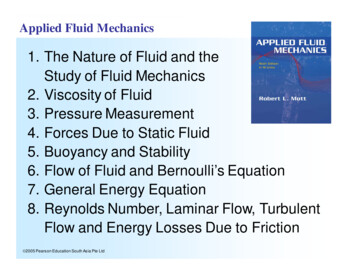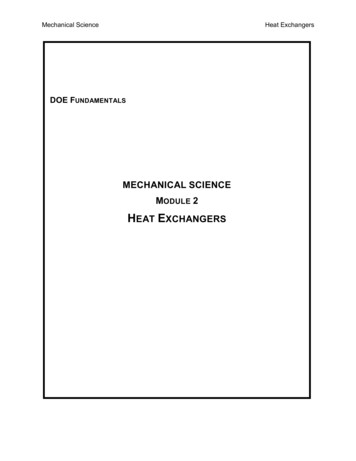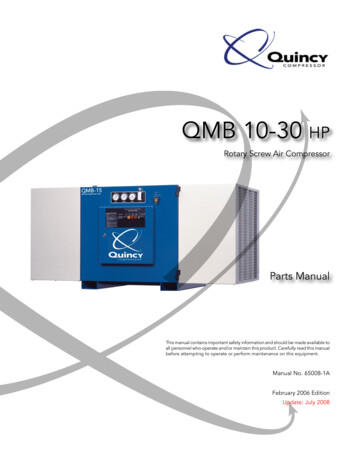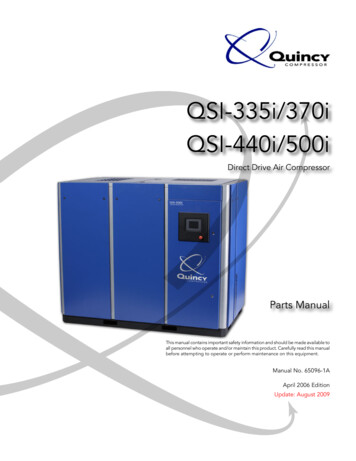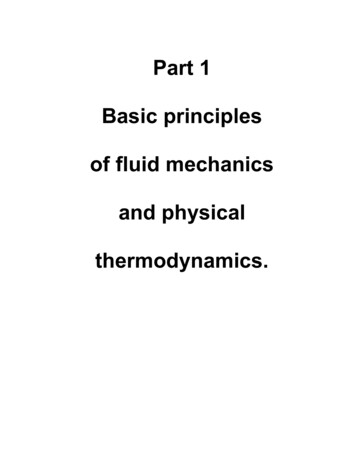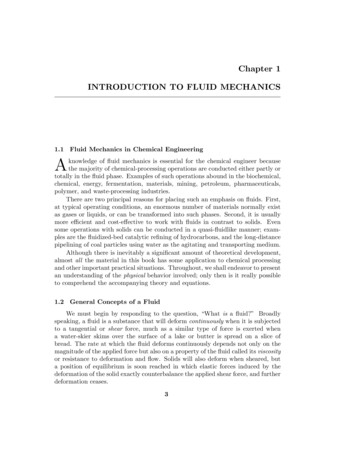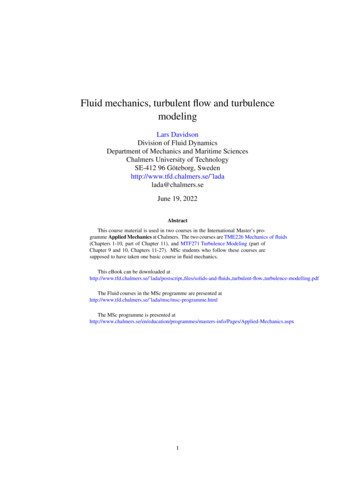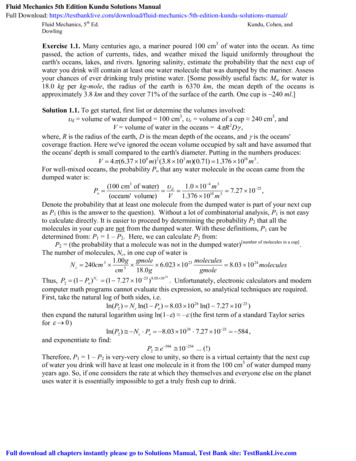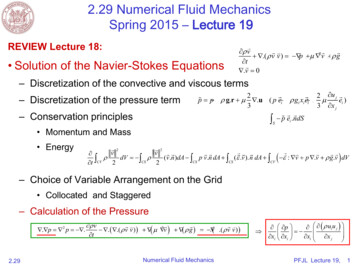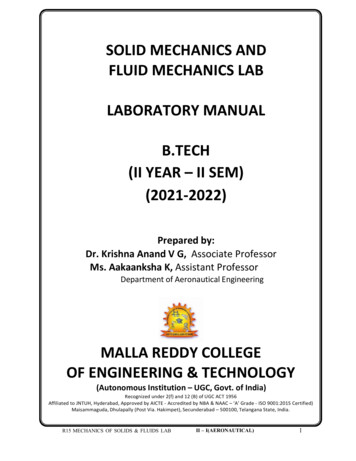
Transcription
SOLID MECHANICS ANDFLUID MECHANICS LABLABORATORY MANUALB.TECH(II YEAR – II SEM)(2021-2022)Prepared by:Dr. Krishna Anand V G, Associate ProfessorMs. Aakaanksha K, Assistant ProfessorDepartment of Aeronautical EngineeringMALLA REDDY COLLEGEOF ENGINEERING & TECHNOLOGY(Autonomous Institution – UGC, Govt. of India)Recognized under 2(f) and 12 (B) of UGC ACT 1956Affiliated to JNTUH, Hyderabad, Approved by AICTE - Accredited by NBA & NAAC – ‘A’ Grade - ISO 9001:2015 Certified)Maisammaguda, Dhulapally (Post Via. Hakimpet), Secunderabad – 500100, Telangana State, India.R15 MECHANICS OF SOLIDS & FLUIDS LABII – I(AERONAUTICAL)1
MALLA REDDY COLLEGEOF ENGINEERING & TECHNOLOGY(Autonomous Institution – UGC, Govt. of India)Recognized under 2(f) and 12 (B) of UGC ACT 1956Affiliated to JNTUH, Hyderabad, Approved by AICTE - Accredited by NBA & NAAC – ‘A’ Grade - ISO 9001:2015 Certified)Maisammaguda, Dhulapally (Post Via. Hakimpet), Secunderabad – 500100, Telangana State, India.MALLA REDDY COLLEGE OF ENGINEERING &TECHNOLOGYVISIONTo establish a pedestal for the integral innovation, team spirit, originality andcompetence in the students, expose them to face the global challenges and becometechnology leaders of Indian vision of modern society.MISSIONTo become a model institution in the fields of Engineering, Technology andManagement.To impart holistic education to the students to render them as industry readyengineers.To ensure synchronization of MRCET ideologies with challenging demands ofInternational Pioneering Organizations.QUALITY POLICYTo implement best practices in Teaching and Learning process for both UG and PGcourses meticulously.To provide state of art infrastructure and expertise to impart the quality education.To groom the students to become intellectually creative and professionallycompetitive.To channelize the activities and tune them in heights of commitment and sincerity, therequisites to claim the never ending ladder of SUCCESS year after year.For more information: www.mrcet.ac.inR20 SOLID MECHANICS AND FLUID MECHANICS LABR20 SOLID MECHANICS & FLUID MECHANICS LABII – I I(AERONAUTICAL)2
DEPARTMENT OF AERONAUTICALENGINEERINGVISIONDepartment of Aeronautical Engineering aims to be indispensable sourcein AeronauticalEngineering which has a zeal to provide the value driven platform for the students to acquireknowledge and empower themselves to shoulder higher responsibility in building a strongnation.MISSIONa) The primary mission of the department is to promote engineering education and research.(b) To strive consistently to provide quality education, keeping in pacewith time andtechnology.(c) Department passions to integrate the intellectual, spiritual, ethical and social developmentof the students for shaping the m into dynamic engineers.R20 SOLID MECHANICS AND FLUID MECHANICS LABR20 SOLID MECHANICS & FLUID MECHANICS LABII – I I(AERONAUTICAL)3
PROGRAM OBJECTIVES (PO’S)9.Engineering Graduates will be able to:1. Engineering knowledge: Apply the knowledge ofmathematics,science,engineering fundamentals, and an engineering specialization to the solution ofcomplex engineering problems.2. Problem analysis: Identify, formulate, review research literature, and analyzecomplex engineering problems reaching substantiated conclusions using firstprinciples of mathematics, natural sciences, and engineering sciences.3. Design / developmen oft solutions: Design solutions for complex engineeringproblems and design system components or processes that meet the specified needswith appropriate consideration for the public health and safety, and the cultural,societal, and environmental considerations.4. Conduct investigations of complex problems: Use research-based knowledge andresearch methods including design of experiments, analysis and interpretation ofdata, and synthesis of t h e information to provide valid conclusions.5. Modern tool usage: C reate, select, and apply appropriate techniques, resources,and modern engineering and IT tools including prediction and modeling tocomplex engineering activities with an understanding of the limitations.6. The engineer and society: Apply reasoning informed by the contextual knowledgeto assess societal, health, safety, legal and cultural issues and the consequentresponsibilities relevant to the professional engineering practice.7. Environment and sustainability: Understand the impact of the professionalengineering solutions in societal and environmental contexts, and demonstrate theknowledge of, and need for sustainable development.8. Ethics: Apply ethical principles and commit to professional ethicsandresponsibilities and norms of the engineering practice.Individual and team work: Function effectively as an individual, and as amember or leader indiverse teams, and in multidisciplinary settings.10. Communication: Communicate effectively on complex engineering activities withthe engineering community and with society at large, such as, being able tocomprehend and write effective reports and design documentation, make effectivepresentations, and give and receive clear instructions.11. Project management and finance: Demonstrate knowledge and understanding ofthe engineering and management principles and apply these to one’s own work, asa member and leader in a team, to manage projects and in multi disciplinaryenvironments.12. Life- long learning: Recognize the need for, and have the preparation and abilityto engage in independent and life-long learning in the broadest context oftechnological change.R20 SOLID MECHANICS AND FLUID MECHANICS LABR20 SOLID MECHANICS & FLUID MECHANICS LABII – I I(AERONAUTICAL)4
PROGRAMME EDUCATIONAL OBJECTIVES (PEO’S)PEO1: PROFESSIONALISM & CITIZENSHIPTo create and sustain a community of learning in which students acquire knowledge and learnto apply it professionally with due consideration for ethical, ecological and economic issues.PEO2: TECHNICAL ACCOMPLISHMENTSTo provide knowledge based services to satisfy the needs of society and the industry byproviding hands on experience in various technologies in core field.PEO3: INVENTION, INNOVATION AND CREATIVITYTo make the students to design, experiment, analyze, interpret in the core field with the helpof other multi disciplinary concepts wherever applicable.PEO4: PROFESSIONAL DEVELOPMENTTo educate the students to disseminate research findings with good soft skills and become asuccessful entrepreneur.PEO5: HUMAN RESOURCE DEVELOPMENTTo graduate the students in building national capabilities in technology, education andresearch.R20 SOLID MECHANICS AND FLUID MECHANICS LABR20 SOLID MECHANICS & FLUID MECHANICS LABII – I I(AERONAUTICAL)5
PROGRAM SPECIFIC OBJECTIVES (PSO’s)1. To mould students to become a professional with all necessary skills, personality andsound knowledge in basic and advance technological areas.2. To promote understanding of concepts and develop ability in design manufacture andmaintenance of aircraft, aerospace vehicles and associated equipment and developapplication capability of the concepts sciences to engineering design and processes.3. Understanding the current scenario in the field of aeronautics and acquire ability to applyknowledge of engineering, science and mathematics to design and conduct experiments inthe field of Aeronautical Engineering.E4. To develop leadership skills in our students necessary to shape the social, intellectual,businessandR20 SOLID MECHANICS AND FLUID MECHANICS LABR20 SOLID MECHANICS & FLUID MECHANICS LABtechnicalII – I I(AERONAUTICAL)worlds6
II Year B.Tech. ANE- II SemL/T/P/C-/-/3/1.5(R20A2183) Solid Mechanics and Fluid Mechanics LabObjectives:1. To supplement the theoretical knowledge gained in Mechanics of Solids withpractical testing for determining the strength of materials under externally appliedloads.2. To analyze various strength of materials3. To understand various characterization methods4. To conduct experiments to verify fundamental principles of fluid mechanics.5. To calibrate measuring devices and analyze experimental data(A) SOLID MECHANICS LAB:1. Direct tension test2. Torsion test3. Hardness testa) Brinells hardness testb) Rockwell hardness test4. Test on springs5. Compression test on cube6. Impact test7. Punch shear test(B) FLUID MECHANICS LAB8. Calibration of Venturimeter9. Calibration of orifice meter10. Verification of Bernoulli’s apparatus.11. Pipe friction.12. Determination of co-efficient of discharge for external Mouth Piece.Note: Any 10 experiments can be conducted minimum five from each section.Equipmentneeded SM – lab1. UTM – 20 / 40 Tons with load Vs Elongation graphical attachment and provisionfor Bending and sheering along with accessories and end grips2. Deflection test rig (Fabricated hardware precession dial gauge)3. Torsion testing Machine4. Hardness testing Machine ( Brinnel and Rockwell)5. Impact Testing Machine6. Spring testing Machine.R20 SOLID MECHANICS AND FLUID MECHANICS LABR20 SOLID MECHANICS & FLUID MECHANICS LABII – I I(AERONAUTICAL)7
FM – lab1. Venturimeter test rig2. Test rig for Flow over notch3. Pipe friction apparatus4. Bernoulli’s apparatus5. test rig for Orifice meter6. Mouthpiece apparatus.Outcomes:1. Prove good understanding of concepts and their applications in the laboratory2. Analyze various strength of materials through characterization3. Understand various characterization methods depending on the type of loading.4. Ability to use equipment for flow measurements.5. Ability to analyze experimental data and develop empirical equations.R20 SOLID MECHANICS AND FLUID MECHANICS LABR20 SOLID MECHANICS & FLUID MECHANICS LABII – I I(AERONAUTICAL)8
CONTENTSSOLID MECHANICS LABORATORYS.No NAME OF THE EXPERIMENTPAGE NoEQUIPMENT USED1Impact Izod Test10Izod impact testing machine2Rockwell Hardness Test13Rockwell hardness testing machine3Brinells Hardness Test16Brinell’s hardness testing machine4Spring Test19Spring testing machine5Torsion test22Torsion testing machine6Tensile Test25Universal testing machineFLUID MECHANICS LABORATORYS.NoNAME OF THEEXPERIMENTPAGE NoEQUIPMENT USED1Calibration of Venturi meter31Venturi meter test rig2Calibration of Orifice meter35Orifice meter test rig3Pipe friction factor40Pipe friction apparatus4Verification of Bernoullis Theorem 45Bernoullis apparatus6Calibration of Coefficient ofmouth pieceMouth piece setup48R20 SOLID MECHANICS AND FLUID MECHANICS LABR20 SOLID MECHANICS & FLUID MECHANICS LABII – I I(AERONAUTICAL)9
MECHANICS OF SOLIDSEXPERIMENT -1IZOD IMPACT TESTAIM: To perform the izod impact test on materials.APPARATUS: Izod impact test machine, test specimen, vernier calipers, steel rule.IMPACT STRENGTH: The resistance of a material to fracture under sudden loadapplicationMATERIALS: Two types of test pieces are used for this test as given.1) Square cross-section2) Round cross-section.THEORY: The type of test specimen used for this test is a Square Cross-sectionThe specimen may have single, two or three notches. The testing machine should have thefollowing specifications.The angle between top face of grips and face holding the specimenvertical 900 The angle of tip of hammer 750 10The angle between normal to the specimen and underside face of the hammer atstrikingpoint 100 10Speed of hammer at impact 3.99m/sec Striking energy 168N-m or Joules Angle of drop ofpendulum 900 Effective weight of pendulum 21.79kgMinimum value of scale graduation 2 Joules.Permissible total friction loss of corresponding energy 0.50%Distance from the axis of rotation of distance between the base of specimen notch and thepoint of specimen hit by the hammer 22mm 0.5mmThe longitudinal axes of the test piece shall lie in the plane of swing of the center of gravityof the hammer. The notch shall be positioned so that it is in the plane of the hammer .thenotch shall be positioned its plane of symmetry coincides with the top face of the grips .forsetting the specimen the notch impact strength I is calculated according to the followingrelation.where I impact strength in joules/m2R20 SOLID MECHANICS AND FLUID MECHANICS LABR20 SOLID MECHANICS & FLUID MECHANICS LABII – I I(AERONAUTICAL)10
PROCEDURE:1. For conducting Izod test, a proper striker is to be fitted firmly to the bottom of thehammer with the help of the clamming piece.2. The latching take for izod test is to be firmly fitted to the bearing housing at the side ofthe columns.3.The frictional loss of the machine can be determined by free fall test, raise the hammerby hands and latch in release the hammer by operating lever the pointer will then indicate theenergy loss due to friction. From this reading confirm that the friction loss is not exceeding0.5% of the initial potential energy. Otherwise frictional loss has to be added to the finalreading.4. The specimen for izod test is firmly fitted in the specimen support with the help ofclamping screw and élan key. Care should be taken that the notch on the specimen shouldface to pendulum striker.5. After ascertaining that there is no person in the range of swinging pendulum, release thependulum to smash the specimen.6. Carefully operate the pendulum brake when returning after one swing to stop theoscillations.7. Read-off position of reading pointer on dial and note indicated value.8. Remove the broken specimen by loosening the clamping screw.The notch impact strength depends largely on the shape of the specimen and the notch. Thevalues determined with other specimens therefore may not be compared with each other.OBSERVATION TABLE:S .NoA(Area of crosssection ofspecimen)K Impact energyobservedR20 SOLID MECHANICS AND FLUID MECHANICS LABR20 SOLID MECHANICS & FLUID MECHANICS LABI Impact StrengthII – I I(AERONAUTICAL)11
Calculation Part:RESULT:EXERCISE PROBLEMSPerform the same experiment for two different materials i.e., Alluminum and Mild SteelR20 SOLID MECHANICS AND FLUID MECHANICS LABR20 SOLID MECHANICS & FLUID MECHANICS LABII – I I(AERONAUTICAL)12
EXPERIMENT -2ROCKWELL HARDNESS TESTAIM: To determine the Rockwell hardness of the given test specimen.APPARATUS: Rockwell hardness testing machine, test specimen.THEORY: Hardness-the resistance of a metal to plastic deformation againstindentation scratching, abrasion or cutting.The depth of penetration of the indenter measures the hardness of a material by thisRockwell’s hardness test method. The depth of penetration is inversely proportional to thehardness. Both ball or diamond cone types of indenters are used in this test. There are threescales on the machine for taking hardness readings.Scale „A- with load 60kgf or 588.8N and diamond indenter is used for performing tests onsteel and shallow case hardened steel.Scale „B- with load 100kgf or 980.7 N and 1.588mm dia ball indenter is used for performingtests on soft steel, malleable iron, copper and aluminum alloys.Scale „C- with load 150kgf or 1471 N and diamond indenter is used for performing tests onsteel, hard cost steel, deep case hardened steel , other metals which harder.First minor load is applied to overcome the film thickness on the metal surface. Minor loadalso eliminates errors in the depth of measurement due to spring of the machine frame orsetting down of the specimen and table attachments.The Rockwell hardness is derived from the measurement of the depth of the impression. Thismethod of test is suitable for finished or machined parts of simple shapes.PROCEDURE:1. Select the load by rotating the nob and fix the suitable indenter.2. Clean the test piece and place on the special anvil or worktable of the machine.3. Turn the capstan wheel to evaluate the test specimen into contact with the indenter point.4. Further turn the wheel for three rotations forcing the test specimen against the indenter.This will ensure the minor load has been applied.5. As soon as the pointer comes to rest pull the handle in the reverse direction slowly. Thisreleases the major but not the minor load. The pointer will now rotate in the reversedirection.R20 SOLID MECHANICS AND FLUID MECHANICS LABR20 SOLID MECHANICS & FLUID MECHANICS LABII – I I(AERONAUTICAL)13
6. The Rockwell hardness can read off the scale dial, on the appropriate scale, after thepointer comes to rest.OBSERVATIONS:Material of the specimenThickness of test specimenHardness scale usedTestnoMaterial Rockwell Scaleof kwellno.3PRECAUTIONS:1. For testing cylindrical test specimens use V-type platform.2. Calibrate the machine occasionally by using standard test blocks.3. For thin metal prices place another sufficiently thick metal piece between thetest specimen and the platform to avoid any damage, which may likely occur to theplatform.4. After applying major load wait for some time to allow the needle to come to rest.The waiting time may vary from 2 to 8 seconds.5. The surface of the test piece should be smooth and even and free from oxide scale andforeign matter.6. Test specimen should not be subjected to any heating of cold working.7. The distance between the centers of two adjacent indentation should be at least 4times the diameter of the indentation and the distance from the center of any indentationto the edge of the test piece should be at least 2.5 times the diameter of the indentation.R20 SOLID MECHANICS AND FLUID MECHANICS LABR20 SOLID MECHANICS & FLUID MECHANICS LABII – I I(AERONAUTICAL)14
Calculation Part:RESULT:EXERCISE PROBLEMSPerform the same experiment for two different materials i.e., Alluminum and MildSteelR20 SOLID MECHANICS AND FLUID MECHANICS LABR20 SOLID MECHANICS & FLUID MECHANICS LABII – I I(AERONAUTICAL)15
EXPERIMENT -3BRINELLS HARDNESS TESTAIM: To determine the Brinells hardness of the given test specimen.APPARATUS: Brinells hardness machine, test specimen, Brinells Microscope.THEORY:Indentation Hardness-A number related to the area or to the depth of theimpression made by an indenter or fixed geometry under a known fixed load.This method consists of indenting the surface of the metal by a hardened steel ballof specified diameter D mm under a given load F kgf and measuring the average diameter dmm of the impression with the help of Brinell microscope fitted with a scale. The Brinellhardness HB is defined, as the quotient of the applied force F divided by the spherical area ofthe impression.HB Test load in kgf/surface area of indentation 2F/ {πD (D- D2- d2)} kg/mm2Where F Applied load in kgD Diameter of the specified ball in mmd Diameter of impression in mmPROCEDURE:1. Select the proper size of the ball and load to suit the material under test.2. Clean the test specimen to be free from any dirt and defects or blemishes.3. Mount the test piece surface at right angles to the axis of the ball indenter plunger.4. Turn the platform so that the ball is lifted up.5. By shifting the lever applies the load and waits for some time.6. Release the load by shifting the lever.7. Take out the specimen and measure the diameter of indentation by means of the Brinellmicroscope.8. Repeat the experiments at other positions of the test piece.9. Calculate the value of HB.R20 SOLID MECHANICS AND FLUID MECHANICS LABR20 SOLID MECHANICS & FLUID MECHANICS LABII – I I(AERONAUTICAL)16
OBSERVATIONS:Test piece material Diameter of the ball” D “ Load section F/D2Test loadLoad application timeLeast count of Brinell Microscope DiameterAverageImpressionS. No(d1)(d2)FDHBin kgin mmKg/mm2(d1 d2)/2PRECAUTIONS:1. The surface of the test piece should be clean2. The testing machine should be protected throughout the test from shock or vibration.3. The test should be carried out at room temperature.4. The distance of the center of indentation from the edge of test piece should be at least 2.5times the diameter of the indentation and the distance between the center of the two adjacentindentations should be at least 4 times the diameter of the indentation.5. The diameter of each indentation should be measured in two directions at right anglesand the mean value readings used the purpose of determining the hardness number.R20 SOLID MECHANICS AND FLUID MECHANICS LABR20 SOLID MECHANICS & FLUID MECHANICS LABII – I I(AERONAUTICAL)17
Calculation Part:RESULT:R20 SOLID MECHANICS AND FLUID MECHANICS LABR20 SOLID MECHANICS & FLUID MECHANICS LABII – I I(AERONAUTICAL)18
EXPERIMENT -4SPRING TESTAIM: To determine the rigidity modulus of the springAPPARATUS: Spring testing machine, vernier calipers, spring specimen.THEORY:Closed coiled helical springs are the springs in which helix angle is very small or inother words the pitch between two adjacent turns is small, a closed coiled helical springcarrying an axial load.As helix angle in case of close coiled helical springs are small, hencethe bending effect on the spring is ignored and we assume that the coils of close coiled helicalsprings are to stand purely tensional stresses.Let d diameter of the spring wireP pitch of the helical spring N number of coilsR mean radius of the spring coilW axial load on spring C modulus of rigidityτ maximum shear stress induced in the wire θ angle of twist in thespring wire andx deflection of spring due to axial load l length of wireNet twisting moment on the wire T WRBut twisting moment is also given by T (π/16) τd3From (1) and(2)above equation which gives the maximum shear stress induced in the wire(1)Length of one coil 2πR(2)Total length of the wire 2πRnStrain energy stored by the spring due to torsionU (τ /4C) [(π/4)d 2πRn](3)Work done on the spring average load x deflection (1/2) WxR20 SOLID MECHANICS AND FLUID MECHANICS LABR20 SOLID MECHANICS & FLUID MECHANICS LAB(4)II – I I(AERONAUTICAL)19
Equating (3) and(4)(1/2) Wx (32W2R3n)/Cd4x 64WR3n/Cd4Rigidity modulus of the spring C 64WR3n/xd4PROCEDURE:1) Consider the spring and find out its mean coil radius R with the help of verniercalipers.2) Find the diameter of the spring and number of turns.3) Fix the spring between two hooks.4) Now load is gradually applied.5) Note the deflection from the deflection scale for different loads applied.6) Calculate the rigidity modulus using above formula.PRECAUTIONS:1) Dimensions should be measure accurately with the help of vernier calipers.2) Deflection from the scale should be noted carefully and accuratelyOBSERVATION TABLE:S.noLoad applieddeflectionRigidity modulusCAverage rigidity modulus C R20 SOLID MECHANICS AND FLUID MECHANICS LABR20 SOLID MECHANICS & FLUID MECHANICS LABII – I I(AERONAUTICAL)20
Calculation Part:RESULT:R20 SOLID MECHANICS AND FLUID MECHANICS LABR20 SOLID MECHANICS & FLUID MECHANICS LABII – I I(AERONAUTICAL)21
EXPERIMENT -5TORSION TESTAIM: To conduct torsion test on mild steel or cast iron specimen to find modulus of rigidityor to find angle of twist of the materials which are subjected to torsion.APPARATUS:1. A torsion test machine along with angle of twist measuring attachment.2. Standard specimen of mild steel or cast iron.3. Steel rule.4. Vernnier caliper or a micrometer.THEORY:For transmitting power through a rotating shaft it is necessary to apply a turningforce. The force is applied tangentially and in the plane of transverse cross section. Thetorque or twisting moment may be calculated by multiplying two opposite turning moments.It is said to be in pure torsion and it will exhibit the tendency of shearing off at every crosssection which is perpendicular to the longitudinal axis.Torsion equation:Torsion equation is given by belowT / IP Cθ/L τ/RT maximum twisting torque(Nmm) IP polar moment ofinertia (mm4)τ shear stress (N/mm2)C modulus of rigidity (N/mm2)θ angle of twist in radiansL length of shaft under torsion (mm)Assumptions made for getting torsion equation1. The material of the shaft is uniform throughout.2. The shaft, circular in section remain circular after loading.R20 SOLID MECHANICS AND FLUID MECHANICS LABR20 SOLID MECHANICS & FLUID MECHANICS LABII – I I(AERONAUTICAL)22
3. Plane sections of shaft normal to its axis before loading remain plane after the torquehave been applied.4. The twist along the length of the shaft is uniform throughout.5. The distance between any two normal-sections remains the same after the applicationof torque.6. Maximum shear stress induced in the shaft due to application of torque does notexceed its elastic limit.PROCEDURE:1. Select the suitable grips to suit the size of the specimen and clamp it in the machineby adjusting sliding jaw.2. Measure the diameter at about the three places and takeaverage value.3. Choose the appropriate loading range depending upon specimen.4. Set the maximum load pointer to zero5. Carry out straining by rotating the hand wheel or by switching on the motor.6. Load the members in suitable increments, observe and record strain reading.7. Continue till failure of the specimen.8. Calculate the modulus of rigidity C by using the torsion equation.9. Plot the torque –twist graph (T Vs θ)OBSERVATIONS:Gauge length L Polar moment of inertia IP Modulus of rigidityS.NoTwistingKgfC TL/ IP θ MomentNmAngle of TwistDegrees RadiansR20 SOLID MECHANICS AND FLUID MECHANICS LABR20 SOLID MECHANICS & FLUID MECHANICS LABModulusAverageof rigidityCC N/mmII – I I(AERONAUTICAL)23
Calculation Part:RESULT:ExercisePerform the same experiment for two different cross sections on a given specimensFor Mild Steel and AlluminumR20 SOLID MECHANICS AND FLUID MECHANICS LABR20 SOLID MECHANICS & FLUID MECHANICS LABII – I I(AERONAUTICAL)24
EXPERIMENT -6TENSILE TESTAIM:To conduct tensile test on a mild steel specimen and determine the following1. Limit of proportionality2. Elastic Limit3. Upper yield point4. Lower yield point5. Ultimate strength6. Fracture strength7. Young s Modulus8. Percentage elongation9. Percentage reduction in area10. Ductility11. Toughness12. True stress & true strain13. MalleabilityAPPARATUS: Universal testing machine, specimen, steel rule, vernier caliper, micrometerTHEORY:The tensile test is most applied one of all mechanical tests. In this test, a test specimen isfixed into grips connected to a straining device and to a load-measuring device. (One end instationary grips and the others are in movable grips). If the applied load is small enough, thedeformation of any solid body is entirely elastic. An elastically deformed solid will return toits original form as soon as load is removed. However if the load is too large, the material canbe deformed permanently. The initial part of the tension curve, which represents the mannerin which solid undergoes plastic deformation is termed as plastic. The stress below which thedeformation is essentially entirely elastic is known as the elastic limit of the material. In somematerials like mild steel a sudden drop in load indicating both an upper and lower yield pointdenotes the onset of plastic deformation. However some materials do not exhibit a sharp yieldpoint. During plastic deformation at lager extensions, strain hardening cannot compensate forthe decrease in section and thus the load passes through a maximum and then begins todecrease. At this stage the ultimate strength, which is defined as the ration of the load on thespecimen to the original cross-section area, reaches a maximum value. Until this point thedeformation is uniform at all the sections of the specimen. Further loading will eventuallycause „neck‟ formation and rupture follows. Usually a tension test is conducted at roomtemperature; the tensile load is applied slowly. During this test either round or flatspecimens may be used. The load on the specimen is applied mechanically or hydraulicallydepending on the type of testing machine.R20 SOLID MECHANICS AND FLUID MECHANICS LABR20 SOLID MECHANICS & FLUID MECHANICS LABII – I I(AERONAUTICAL)25
1. Nominal/Engg stress and Nominal/Engg strain:Original C/S area A0 (mm2)Original gauge length L0 (mm)Increase in gauge length δL0Nominal stress P/A0 (N/ mm2)Nominal strain δL0/L02. Limit of Proportionality:Stress is proportional to strain up to this point.Normal Stress PA/ PONormal Strain (δ LO) A/LO3. Elastic limit:When the load is removed at “B” , the specimen will go back to originalDimensions i.e LO and δAO Nominal stress PB/AONormal Strain (δ LO) B/LOIf the specimen is loaded beyond elastic limit it will undergo permanent strainie. Plastic deformation.4. Upper yield point:Nominal stress PC/AONominal strain (δ LO) D/LO5. Lower yield point:Nominal stress PD/AONominal strain (δ LO) D/LO6. Ultimate load or maximum load point:Nominal ultimate stress PE/AONominal strain (δ LO) E/LO7. Fracture Load point F:Nominal fracture stress PF/AONominal strain at fracture (δ LO) F/LOR20 SOLID MECHANICS AND FLUID MECHANICS LABR20 SOLID MECHANICS & FLUID MECHANICS LABII – I I(AERONAUTICAL)26
8. Young smodulus (E):Young s modulus (E) Stress/Strain(In elastic region, limit of proportionality Nominal stress at A/Nominal strain at A9. Modulus of resilience (Nominal stress at elastic limit)2 /2EArea under Engg. Stress - Strain diagram up to elastic limit10. Resilience Modulus of Resilience x Volume of specimen undergoing Tensile stress.11. Yield point Elongation:Elongation taking place in the specimen from C to D. this istaking place without increase in stress.12. Modulus of toughness:Area under engineering stress – strain diagram up to fracture 13. Toughness Modulusof toughness x Volume of specimen. This indicates the amount of energy absorbed by thespecimen before fracture take place.14. Ductility (Final length at fracture – original length 10) x 10015. Malleability:It is the ability of the material to undergo plastic deformation prior fracture undercompressive loading conditions. In a tensile test it is approximated as percentagereduction in cross sectional area of the specimen. Malleability {(AO - Af)/AO) x 100True stress – true strain diagramEngineering stress is calculated based on original cross sectional area (AO)But not on the actual cross sectional area at load „P‟True stress P/A P/AO x AO/ ASince volume remains c
engineering fundamentals, and an engineering specialization to the solution of complex engineering problems. 2. Problem analysis: Identify, formulate, review research literature, and analyze complex engineering problems reaching substantiated conclusions using first principles of mathematics, natural sciences, and engineering sciences. 3.
